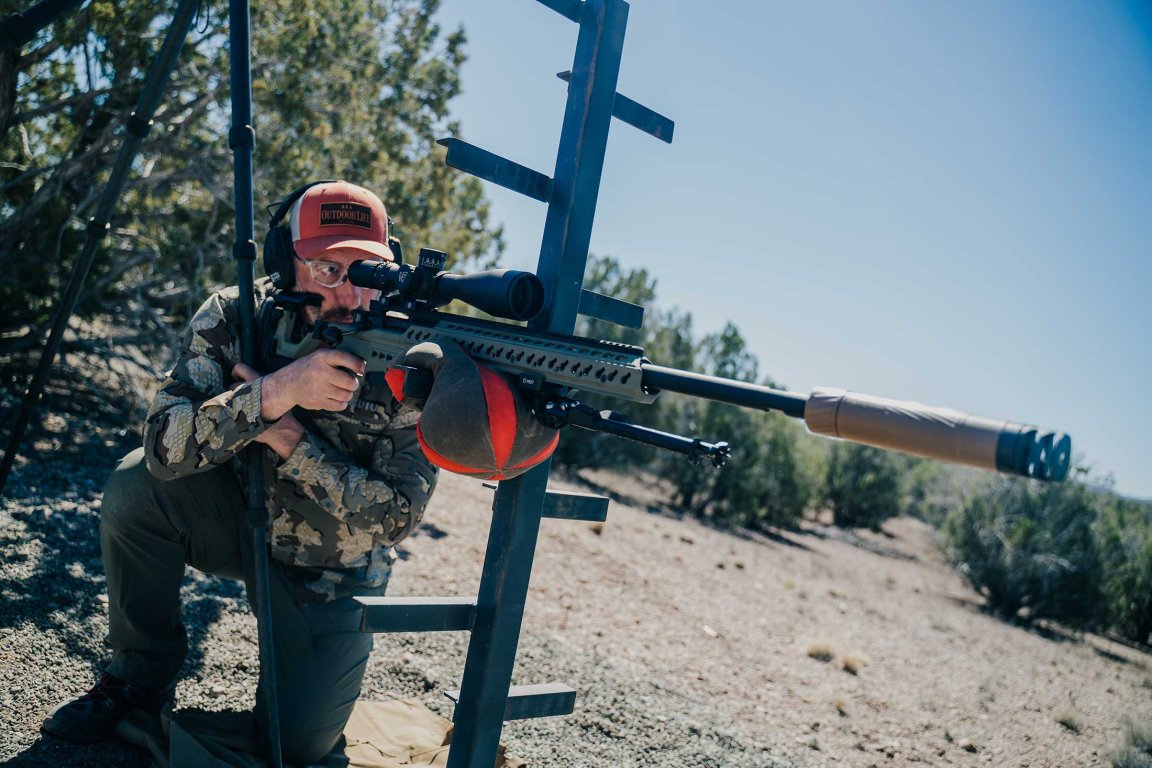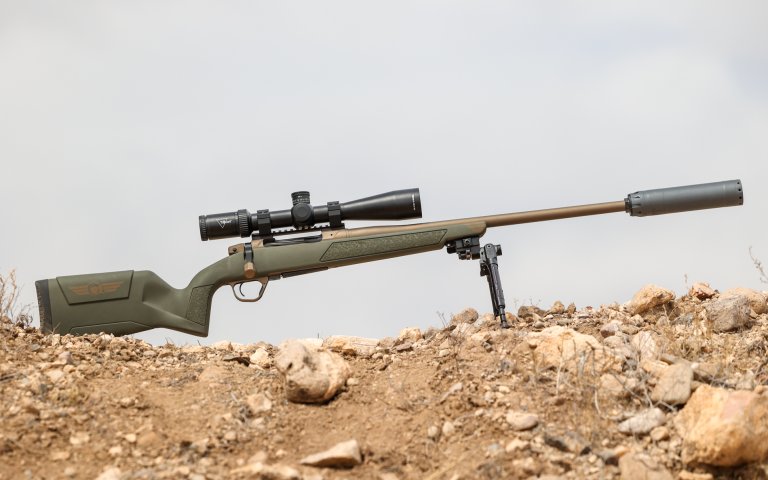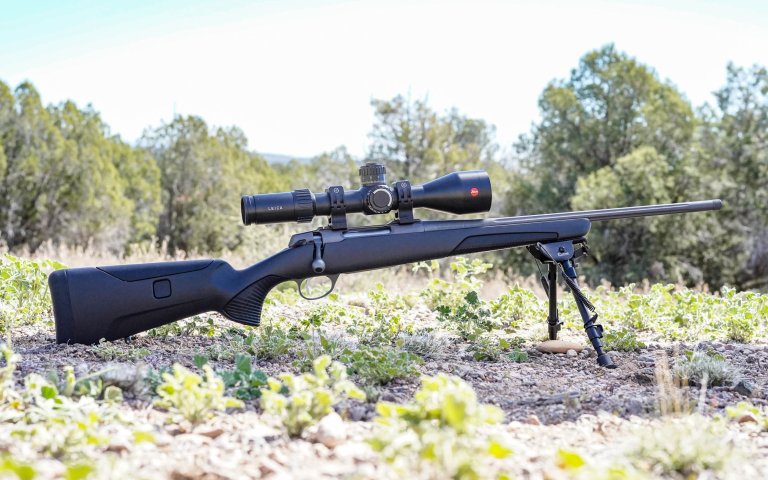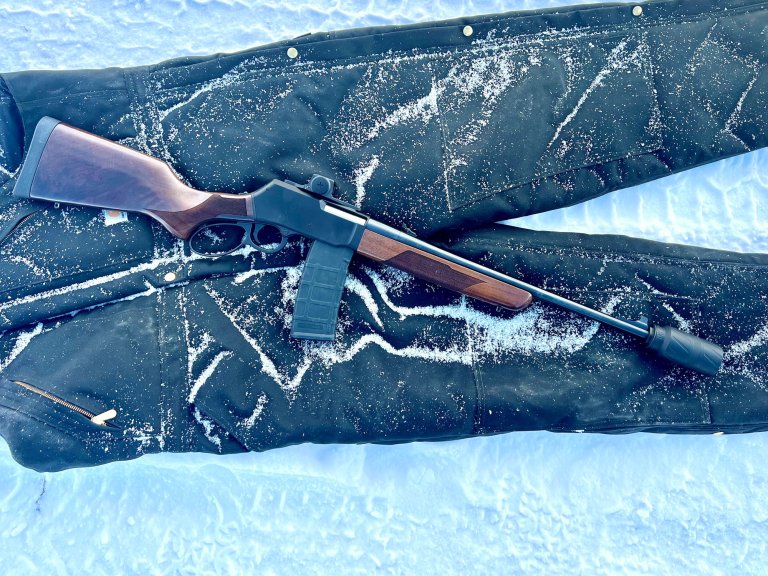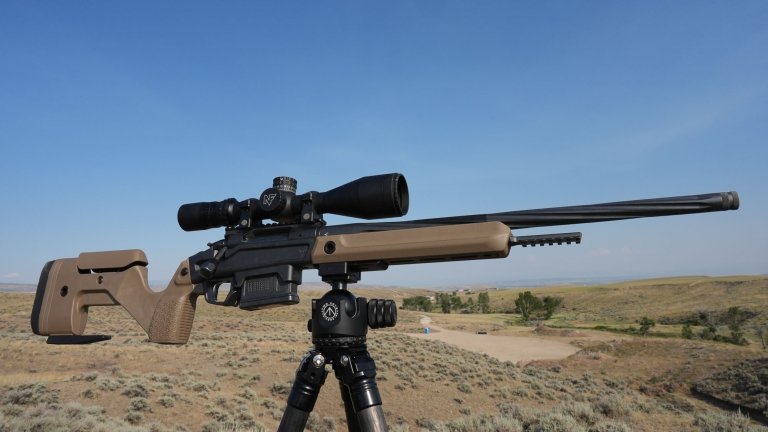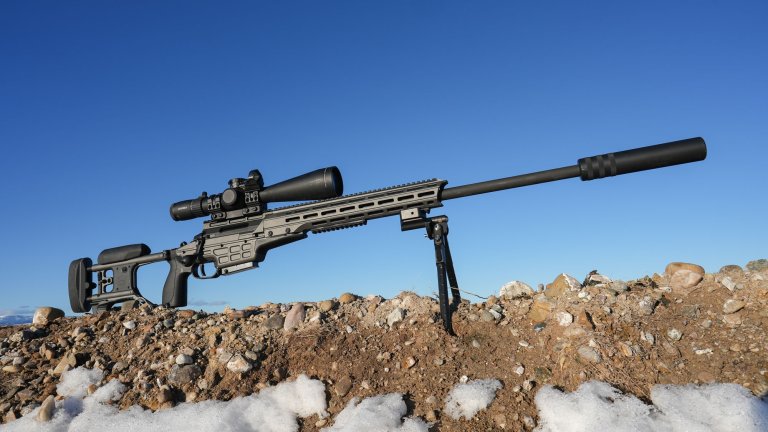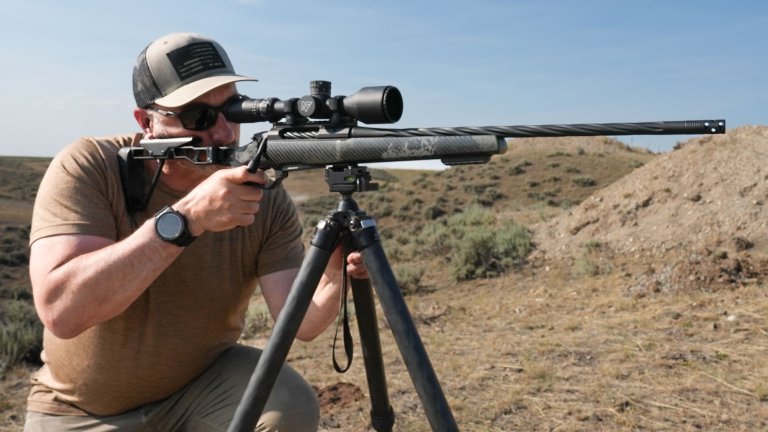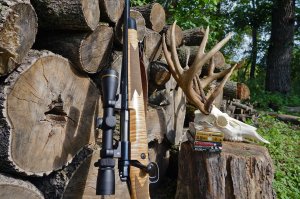We may earn revenue from the products available on this page and participate in affiliate programs. Learn More ›
Wringing out the best rifles of the year requires more than punching holes in paper and measuring groups. Precision, while important, is just one piece of the puzzle. When we grade guns, we do so based on how intuitive and easy they are to operate, how well they are built, how reliably and smoothly they function, what kind of value they represent, and how their design matches up with their intended purpose — all this in addition to how accurate they are.
I took a pile of new rifles down to the high desert in Arizona recently to put them through the paces at Gunsite Academy, which once again hosted the Outdoor Life crew. We spent eight days shooting and, after the smoke cleared and we tabulated our scores, we crowned some impressive winners.
Best New Rifles of 2025
- Editor’s Choice, Best Overall: Accuracy International AT-XC
- Great Buy: Christensen Arms Evoke
- Great Buy: Tikka T3X ACE Target

Without question, the most accurate rifle in this year’s field was the Accuracy International AT-XC, a multi-caliber switch-barrel that’s built with the precision, reliability, and ruggedness the brand is known for. For those who don’t have the budget to throw for an AI, the new Tikka T3X ACE Target is another capable precision rifle but at a more attainable price, which earned it a Great Buy award. For straight up bang-for-the-buck, however, nothing came close to the Christensen Arms Evoke, a budget friendly bolt action that is an accurate and well configured all-around big game hunting rig.
In addition to these winners, we have a number of other rifles to highlight, broken down by key hunting and shooting categories.
Best For Deer and Big Game
- Browning X-Bolt Speed 2
- Geissele King Hunter (new for 2025)
- Sako 90S Adventure
Best Lever Actions
- Smith & Wesson 1854 Stealth (new for 2025)
- Henry Lever Action Supreme (new for 2025)
- Marlin 336 Classic
Best Precision Rifles
- Ruger RPR Gen 4 (new for 2025)
- Stag Arms Pursuit
- Tikka T3X UPR
- Sako TRG 22 A1
Best Mountain Guns
Other New Rifles
Best Rifles of 2025, Reviews & Recommendations
Accuracy International AT-XC (Editor’s Choice)
Pros
- Accurate
- Multi-caliber
- Rugged
- Great Ergonomics
Cons
- Expensive
- Heavy
- Doesn’t include sling attachment point up front
Specs
- Action: Six-lug bolt (two rows of three)
- Stock: Folding aluminum chassis
- Cartridge: 6mm Creedmoor (10+1)
- Weight: 14 pounds, 6 ounces (measured)
- Trigger: 1 pound, 8 ounces (measured)
- Barrel: 26 inches, 1:7 twist, threaded 5/8-24
- Price: $6,538
Key Features
- Easy to use switch barrel design
- Bolts swap for different caliber families
- Light, two-stage competition trigger
- Highly adjustable folding chassis stock
- Runs off AI AWCS magazines
- Fore-end has KeySlot and ARCA attachment points
- Three-position safety

The Accuracy International AT-XC is a precision switch-barrel rifle that’s built for competition and takes many design cues from the company’s world-renowned sniper rifles. In keeping with AI’s reputation, it was the most accurate rifle of this year’s test.
The rifle looks similar to the AT-X it replaced but incorporates a long list of (mostly) under-the-hood upgrades. The receiver is a quarter pound lighter. The force required to lift the bolt has been reduced. The lugs (the rifle has six) have been beefed up and tweaked for a more balanced layout. The firing pin has a flange that prevents the rifle from being able to fire when out of battery. And so on.
Other things remain the same. Changing barrels only requires the loosening of a single 4mm screw on the side of the receiver. The two-stage competition trigger remains one of the best out there for a light, crisp pull in a bomb-proof design.
The receiver has a 20 MOA Pic rail on top that aligns with the 20 MOA rail on the fore-end. Though you can reconfigure the fore-end to be shorter and lighter if you want to make weight class restrictions in competition.
| Ammo | 5-Shot Group Avg. | 20-Shot Group ES | Mean Radius | MV (fps) | ES (fps) | SD (fps) |
| Ber 105-gr HYB | .512 in. | 0.95 in. | 0.18 in. | 2967 | 79.5 | 23.5 |
| Fed 107-gr SMK | .555 in. | 0.68 in. | 0.19 in. | 3087 | 49.4 | 13.1 |
| Hrn 108-gr ELDM | .421 in. | 0.80 in. | 0.24 in. | 3080 | 62.9 | 15.6 |
We got ours chambered in 6mm Creedmoor, a popular choice for long range field-style rifle matches, though we took advantage of its multi-caliber design and tested it in 6.5 Creedmoor as well.
The rifle is so stable, and runs so smoothly, and has such a great trigger that you can’t help but feel like you’re shooting better. The AW magazine system is the slickest out there but, as with the KeySlot system, it’s superior design is also more costly.

While the AT-XC is not a budget rifle, in the world of custom guns (many of which are assembled from off-the-shelf Remington 700 pattern parts) the price isn’t outrageous either.
The point is, the AI AT-XC delivers a lot of value for the price. It is rugged, good looking, a pleasure to shoot, ridiculously accurate, and is a rifle that you can run as hard as you like and it’ll still deliver peak performance. These are the reasons it was our top scoring rifle and overwhelming pick as the Editor’s Choice at this year’s rifle test.
Christensen Arms Evoke (Great Buy)
Pros
- Affordable
- Accurate
- Good Trigger
Cons
- No serious drawbacks
Specs
- Action: Two lug bolt action
- Stock: Synthetic
- Cartridge: 6.5 Creedmoor (3+1)
- Weight: 7 pounds, 8 ounces (measured)
- Trigger: User adjustable, 3 pounds, 6 ounces
- Barrel: 22 inches, 1:8 twist, threaded 5/8-24
- Price: $899
Key Features
- Adjustable trigger
- Comes with 0 MOA Pic rail
- Recessed Pic rail on stock for bipod
- Cerakote finish

The Christensen Arms Evoke is a relief to hunters on a budget who don’t want to compromise on basic functionality. It is a solidly built two-lug bolt action that runs smoothly, delivers very fine accuracy, and has attractive lines and ergonomics.
The rifle has a Remington 700 footprint, and like many actions based on that format it has a plunger ejector, spring blade extractor, bolt release tab on the action, and uses Remington style triggers with a two-position safety. These are all proven design elements and the Evoke smartly didn’t attempt to stray into uncharted territory.
| Ammo | 5-Shot Group Avg. | 20-Shot Group ES | Mean Radius | MV (fps) | ES (fps) | SD (fps) |
| Sig 140-gr OTM | .628 in. | .97 in. | .28 in. | 2534 | 82 | 21.6 |
| Ber 135-gr CH | .445 in. | 1.07 in. | .29 in. | 2627 | 56.7 | 12.8 |
| Fed 140-gr FT | .803 in. | 1.18 in. | .33 in. | 2666 | 67.9 | 17.8 |
As you can see from the chart above, the rifle is a shooter. Any mean radius value at .3 inches or below is excellent, especially for a big-game rifle. You wouldn’t go wrong with the Berger 135-grain Classic Hunter or Federal’s 140-grain Fusion Tipped for hunting, and for NRL Hunter matches, the Sig 140-grain OTM will be competitive.
The rifle comes with a 3-round detachable polymer magazine, but it can also run larger AICS pattern mags if you want to boost ammo capacity.
The recessed Picatinny rail is a nice feature on a rifle at this price point and the rear of the rail has a mounting point for traditional swivel stud sling hardware. Textured panels molded into the stock on either side of the fore-end and pistol grip (which is generously sized and has a comfortable hybrid angle) give the shooter good control over the rifle.
The butt stock has a raised cheek piece and a large, cushy recoil pad. The stock’s ergonomics in combination with the recoil pad and the rifle’s 7.5-pound weight make it easy to control.
The crisp adjustable trigger (which we set to 3 pounds, 6 ounces) adds to the pleasure of shooting the Evoke. The suppressor ready barrel, threaded at 5/8-24, is the cherry on top. With a can aboard, the Evoke is a rifle you could shoot all day — which is what we did.
This is a clear winner from Christensen Arms, and given its price point we had zero hesitation bestowing it with a Great Buy award.
Tikka T3X ACE Target (Great Buy)
Pros
- Excellent recoil management
- Slick action
- Good accuracy
- Modular chassis stock
Cons
- Takes proprietary magazine
- Magazine well is tight
Specs
- Action: Three-lug bolt
- Stock: Aluminum chassis
- Cartridge: .308 Win. (10+1)
- Weight: 9 pounds, 12 ounces (measured)
- Trigger: 2 pounds, 15 ounces (measured)
- Barrel: 23.6 inches, 1:10 twist, threaded 5/8-24
- Price: $1,999
Key Features
- Adjustable chassis stock
- Two-stage trigger
- Fore-end has ARCA and M-Lok attachments
- Takes proprietary magazines
- Three-position safety
I can’t remember the last time we shot a Tikka we didn’t like. These rifles, baby brothers to Sako, incorporate a lot of their older sibling’s design features, but have a more attainable price.
That’s definitely the case with the Tikka T3X ACE Target, a hybrid precision rifle that is accurate enough for long range shooting but would make for a good hunting rig under many circumstances.
The action on ours ran with the smooth and unsurprising predictability Tikka is known for, though as with most three-lug designs the bolt takes some effort to cock. Tikka mitigates that somewhat by giving the rifle a large bolt handle.
The fluted stainless-steel bolt glided effortlessly in the receiver, and the double-stack 10-round magazine fed our .308 ammo flawlessly.
| Ammo | 5-Shot Group Avg. | 20-Shot Group ES | Mean Radius | MV (fps) | ES (fps) | SD (fps) |
| Ber 168-gr CH | .383 in. | .59 in. | .20 in. | 2565 | 44.3 | 13 |
| Ber 168-gr CH | .566 in. | .76 in. | .24 in. | 2560 | 73.7 | 22.7 |
| Fed 168-gr CTR | .812 in. | 1.10 in. | .30 in. | 2674 | 65.3 | 17.9 |
| Hrn 168-gr A-Max | .723 in. | 1.32 in. | .37 in. | 2687 | 55.8 | 15.6 |
| Nos 165-gr WT | 1.06 in. | 1.64 in. | .50 in. | 2852 | 64.4 | 14.3 |
The rifle really liked every 168-grain load we shot through it — whether match ammo (Federal Centerstrike and Hornady A-Max) or hunting rounds (Berger Classic Hunter and Nosler’s new Whitetail line).
The aluminum chassis stock, which has an easily adjustable cheek piece, includes a plethora of M-Lok slots along the fore-end, an ARCA rail along the bottom, and a barricade stop in front of the magazine well, all of which make it competition ready.

We loved how easily we could drive the rifle. The clever reversible thumb rest that sits above the vertical pistol grip and the hook for the shooter’s support hand on the butt stock helped with that.
One issue we had with the rifle is the snug and straight-sided mag well that made magazine changes sometimes difficult.
Other than that, we are big fans. The three-position safety that locks the bolt down is easy to use, as is the ambidextrous magazine release in front of the trigger guard. The ACE Target isn’t cheap, but in light of what it brings to the table it is one of the best values in a rifle of this type, which is why it earned a Great Buy award.
Best For Deer and Big Game
Browning X-Bolt Speed 2
Pros
- Accurate
- Excellent magazine
- Adjustable comb and length of pull
- Interchangeable grip modules
Cons
- Stiff bolt lift
- Non-standard barrel threading
Specs
- Action: Three-lug bolt
- Stock: Synthetic
- Cartridge: 6.5 Creedmoor (4+1)
- Weight: 6 pounds, 14 ounces (measured)
- Trigger: 3 pounds, 6 ounces (measured)
- Barrel: 22 inches, 1:8 twist, threaded M13-.75
- Price: $1,499
Key Features
- Two-position tang safety
- 4-round rotary magazine
- Raised cheek piece
- Cerakoted barrel and receiver

The Browning X-Bolt Speed 2 is an excellent all-around big-game hunting rifle. It has classic lines and isn’t pretending to be a long-range precision gun, so it will appeal to those who like a bolt-action with traditional lines and handling characteristics. It does, however, feature an adjustable comb piece and length-of-pull inserts, as well as an optional chunky vertical grip module if the shooter prefers that ergonomic.
| Ammo | 5-Shot Group Avg. | 20-Shot Group ES | Mean Radius | MV (fps) | ES (fps) | SD (fps) |
| Ber 135-gr CH | .609 in. | .80 in. | .27 in. | 2622 | 78.8 | 19.3 |
| Fed 140-gr CTR | .657 in. | .89 in. | .28 in. | 2637 | 51.9 | 14.7 |
| Fed 140-gr FT | .567 in. | .92 in. | .31 in. | 2669 | 74.7 | 22.6 |
| BHA 140-gr OTM | 1.08 in. | 1.45 in. | .44 in. | 2671 | 71 | 19 |
The heart of the rifle is the three-lug X-Bolt action which has a compact bolt throw, a fairly stiff bolt lift, and an ergonomic two-position safety on the tang that is positive to operate and ambidextrous. Unlike most two-position safeties, this one locks the bolt down, which is a desirable feature on a hunting rig. A button at the top of the bolt handle allows the user to unlock the bolt to open the action without needing to place the safety on “fire.”
The Smoked Bronze Cerakoting on the barrel and receiver pair nicely with the stock’s Ovix camo finish. Beyond its good looks, the metal finish provides protection from the elements and the matte hues of the gun mean you won’t be betrayed by a glint of sunshine tipping off a deer as you approach.
The non-standard threading on the barrel (M13-.75) means users will need to get an adapter to run 5/8-24 suppressors. This isn’t a huge deal, but it is pesky.
We found the rifle delivered excellent accuracy, which was especially impressive given the barrel’s thin contour. The Berger Classic Hunter, Federal Centerstrike, and Federal Fusion Tipped all hammered in the rifle, printing 20-shot groups under one inch. Handled correctly this rifle will excel in any hunting scenario you might face.
Geissele King Hunter (New for 2025)
Pros
- Slick action
- Ergonomic stock
- Compact overall length
Cons
- Have to lower or remove cheek piece to extract bolt
- 7mm Backcountry doesn’t always extract smoothly
Specs
- Action: Two-lug bolt
- Stock: Manner’s Carbon Fiber
- Cartridge: 7mm Backcountry
- Weight: 8 pounds, 6 ounces
- Trigger: 3 pounds, 5 ounces
- Barrel: 20 inches, 1:8 twist, threaded 5/8-24
- Price: $3800
Key Features
- ARCA rail on stock
- Adjustable cheek piece
- QD Flush Cups
- Integral split Picatinny rail
- Floating bolt head
- Cut-rifled barrel

The King Hunter is one of the most exciting rifle introductions of the year. It is Geissele’s first foray into the bolt action market, and they went all in to produce a rifle with many best-in-class features. On top of that they chambered it in 7mm Backcountry, the hottest new cartridge on the scene.
Geissele, of course, is well known for their triggers, gas guns, and other accessories, so making the leap to producing a bolt action was a natural next step.
The King Hunter is blessed with a super slick two-lug bolt head that is easy to cock and run thanks to the round, oversized bolt knob and nitride coated receiver. The floating bolt head is a proven design that self-aligns with the lug recesses for a perfectly square fit, enhancing accuracy.
| Ammo | 5-Shot Group Avg. | 20-Shot Group ES | Mean Radius | MV (fps) | ES (fps) | SD (fps) |
| Fed 168-gr Barnes LRX | .558 in. | .78 in. | .28 in. | 3051 | 49.2 | 13.7 |
| Fed 170-gr TA | 1.056 in. | 1.59 in. | .41 in. | 3082 | 51 | 16.6 |
| Fed 175-gr FT | 1.172 in. | 1.60 in. | .45 in. | 2990 | 64.9 | 17.1 |
Of the three loads in 7mm Backcountry we had on hand, it did the best with Federal’s 168-grain Barnes LRX, producing an exceptional .78 inch, 20-shot group with a .28-inch mean radius.
Geissele is producing the barrels and triggers for the King Hunter in house. They went with a medium-heavy 20-inch cut-rifle barrel that plays into the 7 BC’s design, which is optimized for short-barreled, suppressed firearms. The two-stage Super 700 Trigger has a substantial take-up, followed by a light and crisp break. It offers a good combo of safety and precise control.
The stock is a version of Manner’s LRH stock, and has a section of ARCA rail in front of the mag well, an adjustable cheek piece, four QD cups, and dual swivel studs up front with one at the rear.

For the price, I wish they had ditched the swivel studs and given the user a section of Pic rail instead. It would be more in keeping with the rifle’s tactical-hunter design.
The only other concern is that the rifle has some difficulty with heavy bolt lift after longer shot strings, an issue we’ve seen with other rifles we’ve tested in 7 BC. While I like this rifle a lot, I think it will be even more impressive when they chamber it in 7 PRC, 6.5 PRC, or when the 7 BC overcomes this initial growing pain.
Sako 90 Adventure (2024 Editor’s Choice)
Pros
- Well balanced
- Accurate
- Great ergonomics
Cons
- Has swivel studs instead of QD cups and a Pic rail
Specs
- Action: Three-lug bolt
- Stock: Fiberglass and carbon fiber
- Cartridge: 6.5 Creedmoor (5+1)
- Weight: 6 pounds, 9 ounces (measured)
- Trigger: User adjustable from 2 pounds 1 ounce to 4 pounds 2 ounces (measured)
- Barrel: 20.1 inches, 1:8 twist, 5/8-24 thread adapter
- Price: $2,555
Key Features
- User adjustable trigger
- Adjustable cheek piece
- Three-position safety

This rifle blew our socks off during the 2024 gun test. Externally it looks like a traditional bolt-action rifle with a stock styled in the American Classic fashion. And that much is true. But once we started running it, we realized it was far from ordinary.
At the end of our evaluation we all felt it was about as perfect a traditional hunting rifle as you might find. It is expensive, yes, but given its flawless performance we agreed it is a tremendous value.
| Ammo | 5-Shot Group Avg. | 20-Shot Group ES | Mean Radius |
|---|---|---|---|
| Ber 144-gr LRHT | .806 in. | 1.05 in. | .31 in. |
| Fed 140-gr CTR | .861 in. | 1.64 in. | .32 in. |
| Sako 120-gr Powerhead | .672 in. | 1.13 in. | .25 in. |
The rifle is accurate, runs like a Jamaican sprinter, and has that “it” factor that is difficult to describe but manifests itself in its wonderful balance and handling qualities.
You can check out my video on it, or read my in-depth review of the Sako 90 Adventure if you want to know more. But it ran away with the Editor’s Choice award for good reason and is still one of the finest hunting rifles made today.
Best Lever Actions
Smith & Wesson 1854 Stealth Hunter (New for 2025)
Pros
- Handles and balances well
- Good trigger
- Suppressor ready
- Quality open sights
Cons
- Handguard gets cold in frigid weather
Specs
- Action: Lever
- Stock: Aluminum fore-end, synthetic butt stock
- Cartridge: .44 Magnum (8+1)
- Weight: 6 pounds, 7 ounces (measured)
- Trigger: 4 pounds, 10 ounces (measured)
- Barrel: 16.3 inches, 1:20 twist, threaded 11/16-24
- Price: $1,399
Key Features
- Aluminum handguard with M-Lok
- Extended Picatinny rail
- Oversized lever loop
- Hi-Viz front sight
- Unloads from front of tubular magazine

With the Stealth Hunter, the latest addition to the 1854 series, Smith & Wesson is leaning into the tacticool aesthetic. This handy .44 Magnum carbine is blacked out, comes with an extended Picatinny rail, has a stout ghost-ring sight, and sports a slick aluminum handguard with M-Lok slots that is comfortable and functional.
The package works. This rifle looks great, runs smoothly, and is a blast to shoot. While it would be perfectly at home on The Last of Us or The Walking Dead, it is also a capable hunting rifle, as Outdoor Life gear editor Scott Einsmann found out while chasing whitetails last fall. (He took a nice buck with Federal’s 270-grain HammerDown.)
| Ammo | 5-Shot Group Avg. | 20-Shot Group ES | Mean Radius | MV (fps) | ES (fps) | SD (fps) |
| Hrn 200-gr HH | 1.44 in. | 1.69 in. | .52 in. | 1692 | 51.3 | 22.9 |
| Hrn 200-gr XTP | 1.77 in. | 1.90 in. | .58 in. | 2046 | 82.4 | 24.7 |
| Fed 270-gr HmmrDwn | 1.30 in. | 1.79 in. | .52 in. | 1670 | 43.3 | 13.5 |
The accuracy we got at 50 yards shows that the Stealth Hunter is more than capable for deer, hogs, bear, and other game you might encounter in brushy country, thick timber, or other tight quarters.
I reviewed the initial Smith & Wesson Model 1854, which won the 2024 Editor’s choice award, so we don’t think you would go wrong with any of the rifles in this series.
Henry Lever Action Supreme (New for 2025)
Pros
- Smooth action
- Trigger has crisp, clean break
- Pairs well with a red-dot sight or compact scope
- Light and handy
Cons
- Almost too pretty to subject to hard use
Specs
- Action: Lever action with rotating AR-style bolt head
- Stock: Walnut
- Cartridge: .223 Rem. / 5.56 NATO (10+1)
- Weight: 6 pounds, 6 ounces (measured)
- Trigger: User adjustable, 3 pounds, 3 ounces (measured)
- Barrel: 18 inches, 1:8 twist, threaded ½-28
- Price: $1,299
Key Features
- Runs with AR-style magazines
- Free-floated barrel
- Tang safety
- Versatile rear sight
- Trigger adjusts from 3 to 6 pounds
- Also available in .300 Blackout
This handsome lever gun is a new design from Henry Repeating Arms, and it is blessed with clean lines, a silky action, an innovative rear sight, and adjustable trigger. Given the level of workmanship, ergonomics, eye-catching aesthetics, and accuracy it is also a solid value for the price.
The carbine runs on AR-15 style magazines and it ships with a polymer 10-round Magpul mag. My first sample was in .223/5.56 NATO, which is featured here, but it’s also available in 300 Blackout.
| Ammo | 5-Shot Group Avg. | 20-Shot Group ES | Mean Radius | MV (fps) | ES (fps) | SD (fps) |
| Fed. 77-gr CTR | .937 in. | 1.62 in. | .40 in. | 2477 | 117.5 | 28.1 |
| Sie 77-gr SMK | .956 in. | 1.47 in. | .46 in. | 2486 | 89.8 | 28.8 |
| Brn 85-gr OTM BT | 1.588 in. | 2.14 in. | .57 in. | 2583 | 64.8 | 15.1 |
The two 77-grain loads I put through it did very well, while the 85-grain Barnes OTM was perfectly acceptable too. For shots on game within 200 yards, this rifle will be deadly.
It comes with open sights, but works well with a red-dot, or an LPVO type scope, which is what I used for the accuracy testing. I reviewed the Henry Lever Action Supreme in depth if you’re interested in learning more.
Marlin 336 Classic (2023 Editor’s Choice)
Pros
- Excellent handling
- Great fit and finish
- Flawless cycling
Cons
- Heavy trigger
- Limited availability
Specs
- Action: Lever
- Stock: Walnut
- Cartridge: .30/30 Winchester (6+1)
- Weight: 7 pounds, 1 ounce (measured)
- Trigger: 8 pounds (measured)
- Barrel: 20 inches with 1:12 twist
- Price: $1,239
Key Features
- Crossbolt safety
- Classic styling
- Walnut stock and blued metal

We’ve had plenty of good things to say about Marlin since they were acquired by Ruger. The quality of these rifles are the best in the company’s history, in fact. The initial 1895 SBL in .45/70 Gov’t has become a favorite hunting companion of mine, while the reintroduced Marlin 336 Classic in .30/30 won an Editor’s Choice Award the year it came out.
Our sample averaged 1.67 inch, 5-shot groups at 100 yards, which we did before we shifted to our current 20-shot protocol.
These rifles exhibit wonderful craftsmanship, are easy on the eyes, and have been a godsend to those of us who feared for Marlin’s future before Ruger came to the rescue.
Best Precision Rifles
Ruger RPR Gen 4 (New for 2025)
Pros
- Accurate
- Easy to adjust stock dimensions
- Modular design easy to customize
- Manages recoil well
Cons
- Long bolt throw
Specs
- Action: Three-lug bolt
- Stock: Folding aluminum
- Cartridge: 6.5 Creedmoor (10+1)
- Weight: 12 pounds, 8 ounces (measured)
- Trigger: 2 pounds, 6 ounces (measured)
- Barrel: 24 inches, 1:8 twist, threaded 5/8-24
- Price: $2,149
Key Features
- Folding stock
- Handguard with M-Lok and ARCA attachment points
- Accepts multiple types of magazines
- 20 MOA Picatinny rail
This latest iteration of the Ruger Precision Rifle, more commonly known as the RPR, is the most refined yet. Now in its fourth generation, it has an improved handguard with an integral ARCA rail, and a redesigned butt stock with toolless, low profile adjustment controls.
Much about this rifle will be familiar to those who’ve shot RPRs in the past. It’s still wonderfully accurate, has the cha-chunk feel to the action when it cycles, uses an AR style grip and safety, with a 45-degree throw.
| Ammo | 5-Shot Group Avg. | 20-Shot Group ES | Mean Radius | MV (fps) | ES (fps) | SD (fps) |
| Fed 140-gr CTR | .447 in. | .86 in. | .25 in. | 2645 | 41.2 | 12.5 |
| Fed 140-gr FT | .728 in. | 1.02 in. | .26 in. | 2667 | 84.1 | 22.8 |
| Ber 135-gr CH | .565 in. | 1.01 in. | .31 in. | 2622 | 123.5 | 27.2 |
| BHA 140-gr OTM | .812 in. | 1.23 in. | .31 in. | 2696 | 63.5 | 17.6 |
It shot everything we put through it really well, and the results with Federal’s Centerstrike and Fusion Tipped ammo were especially impressive. One ergonomic touch I really like is how the safety doubles as a thumb rest for the trigger hand. At $2,149 it isn’t quite the bargain the RPR once represented, but it is still a solid rifle for the money.
Stag Arms Pursuit (2024 Great Buy)
Pros
- Smooth action
- Manages recoil well
- Well thought out ergonomics
Cons
- No major drawbacks
Specs
- Action: Three-lug bolt
- Stock: Synthetic
- Cartridge: 6.5 Creedmoor (5+1)
- Weight: 8 pounds, 15 ounces (measured)
- Trigger: 2 pounds, 14 ounces (measured)
- Barrel: 20 inches, 1:8 twist, threaded 5/8-24
- Price: $1,600
Key Features
- Three-lug action with 60-degree bolt throw
- Synthetic stock is easy to adjust
- Toolless bolt takedown
- Full-length 20-MOA Picatinny rail
- User adjustable trigger
- Dual plunger ejectors
The Stag Arms Pursuit is a solid precision rifle that delivers serious bang for the buck. This Remington 700 pattern bolt gun impressed during our initial evaluation, and it is still a rifle I enjoy shooting.
It checks a lot of boxes that precision rifle shooters look for: adjustable stock, smooth action with an oversized bolt knob, good trigger, 20 MOA Picatinny rail, a bolt that can be disassembled without tools, and excellent ergonomics.
| Ammo | 5-Shot Group Avg. | 20-Shot ES | Mean Radius | |
| Ber 140-gr EH | .706 in. | 1.59 in. | .43 in. | |
For someone looking to get into long-range shooting without breaking the bank, the Pursuit is a smart option, which is why it won a Great Buy award. People who like to shoot suppressed will also appreciate that it comes with a 20-inch barrel. You can check out my full review of the Stag Arms Pursuit as well.
Tikka T3x UPR
Pros
- Smooth action
- Reliable feeding
- Solid ergonomics
Cons
- Not available in 6mm Creedmoor for NRL Competition
- Comes with swivel studs on the fore-end rather than a Pic rail
Specs
- Action: Two-lug bolt
- Stock: Glass fiber with adjustable cheek piece
- Cartridge: 6.5 Creedmoor (10+1)
- Weight: 7 pounds, 14 ounces (measured)
- Trigger: 3 pounds 13 ounces (measured)
- Barrel: 23.7 inches, 1:8 twist, cold-hammer forged, threaded 5/8-24
- Price: $1,299
Key Features
- Adjustable cheek piece
- Adjustable trigger
- 20 MOA Picatinny rail
The Tikka T3x is a popular rifle in the NRL Hunter factory division, and the UPR model is one of the best suited to that sport.
Like the new Tikka T3x ACE Target mentioned above, it runs with predictable smoothness and reliability, effortlessly feeding and ejecting rounds as quickly as you can run the bolt.
The UPR has a couple nice ergonomic touches, like an adjustable cheek piece and a hook under the butt stock to snug the rifle into the shoulder and steady the shot.
In terms of accuracy, it consistently printed 5-shot groups that averaged .75 inches or smaller. Our intensive testing with it predates our 20-shot protocol, so we don’t currently have that data. But as an example, over eight 5-shot groups with factory Hornady 140-grain ELD-M loads the group size averaged .746 inches. Check out this review of the Tikka T3x UPR if you want to learn all the ins and outs.
Sako TRG 22 A1
Pros
- Outstanding accuracy
- Great ergonomics
- Rugged and reliable
Cons
- Expensive
- Lacks ARCA attachments
Specs
- Action: Three-lug bolt
- Stock: Aluminum chassis folder
- Cartridge: 6.5 Creedmoor (10+1)
- Weight: 12 pounds, 7 ounces (empty, no mag, with three M-LOK sections installed)
- Trigger: 2 pounds, 10 ounces (measured)
- Barrel: 26 inches, 1:8 twist, cold-hammer forged, threaded 5/8-24
- Price: $5,400
Key Features
- Two-stage adjustable trigger
- Easy to adjust stock dimensions
- Stiff, positive folding mechanism
- M-Lok slots on hand guard
- On-board tools allow for field maintenance
If accuracy is your thing, then you’re going to love the Sako TRG 22 A1. This Finnish sniper rifle is an absolute hammer when it comes to placing bullets on distant targets with confidence. It is so precise, in fact, that it is one of my baseline rifles for accessing 6.5 Creedmoor ammunition.
It is also built with next-level durability so it can take any measure of punishment you care to dish out. At this point I’ve put well over 2,000 rounds through the rifle, shooting it in sub-zero conditions, exposing it to dust, mud and rain, and treating it like a rented mule.
The rifle just keeps going with its slick action, lovely trigger, and flawless feeding from the proprietary metal magazines.
| Ammo | 5-Shot Group Avg. | 20-Shot Group ES | Mean Radius | MV (fps) | ES (fps) | SD (fps) |
| Sig 140-gr OTM | .330 in. | .60 in. | .18 in. | 2608 | 52.4 | 15.3 |
| Brn Hrv 140-gr TGK | .491 in. | .95 in. | .22 in. | 2692 | 57.6 | 15.7 |
| Ber 135-gr CH | .641 in. | 1.09 in. | .32 in. | 2662 | 60.9 | 17.1 |
These are some recent 20-shot aggregate data we’ve collected. As you can see, it really likes the Sig 140-grain OTMs, but I think how it shot Barnes new Harvest Whitetail ammo — with sub .5 MOA 5-shot groups and a .22-inch mean radius — is equally impressive.
I have a longer review if you want to go down the Sako TRG 22 A1 rabbit hole.
Best Mountain Guns
Proof Glacier Ti
Pros
- Ultralight
- Excellent accuracy
- Excellent workmanship
Cons
- Expensive
Specs
- Action: Two-lug bolt action
- Stock: Carbon fiber
- Cartridge: 6.5 PRC
- Weight: 5 pounds, 5 ounces (measured)
- Trigger: 2 pounds, 3 ounces (measured)
- Price: $7,499
Key Features
- Proof Research carbon-fiber barrel
- Carbon-fiber stock
- BDL-style magazine
This is one of the highest-tech production rifles built today. The Glacier Ti does everything possible to trim weight without sacrificing reliability and accuracy. It’s a tall order, but Proof manages to accomplish this mission.
We’ve shot them in several calibers over the years, including 6.5 Creedmoor, 6.5 PRC, and 7 PRC. All have been hammers. Our most recent testing was with a 22-inch 6.5 PRC. Five-shot groups averaged under .75 inches with Federal 130-grain Terminal Ascent rounds, and other types of ammo did even better.
All of this is from a package that weighs less than 6.5 pounds with a scope. From the flawless bedding job, to the excellent recoil management, the Proof Glacier Ti is as good as it gets in a mountain rifle.
Seekins Precision Havak Slam
Pros
- Ultra light and packable
- Accurate
Cons
- Expensive
- Rifle needs to be driven well for consistent accuracy
Specs
- Action: Four-lug bolt-action (two rows of two)
- Stock: Carbon-fiber folder with aluminum bedding chassis
- Cartridge: 6.5 Creedmoor (3+1)
- Weight: 5 pounds 9 ounces (measured)
- Trigger: 1 pound 15 ounces (measured)
- Barrel: 20 inches; 1:8 twist, threaded 5/8-24
- Price: $4,650
Key Features
- Integral 20 MOA Pic rail with bubble level
- Folding carbon-fiber chassis stock
- Available in short and long action lengths
- Adjustable TriggerTech Diamond trigger
A growing segment in the high-performance rifle market is packable mountain rifles. These are lightweight bolt actions with folding stocks that can be made compact enough to fit inside a backpack if desired.
The Seekins Havak Slam is the most refined example of this category. The stock is stiff and light and it has a strong hinge. It features M-Lok slots along the underside of the fore-end and a trim segment of ARCA rail so it can be shot while clipped into a tripod.
The barrel has a thin contour and is slightly fluted. This reduces weight but also helps the rifle balance with the minimalistic stock. Granted, with a suppressor on board the rifle becomes a bit muzzle heavy, but we found we could still shoulder it quickly and control it during practical shooting drills.
| Ammo | 5-Shot Group Avg. | 20-Shot Group ES | Mean Radius |
| Sig. 140-grain HPBT | .819 in. | 1.19 in. | .33 in. |
Looking at 20-shot groups with certain types of ammunition, the Seekins Slam printed extreme spreads of 1.19 to 1.6 inches. One load that performed particularly well was SigSauer 140-grain HPBT, which had 20-shot mean radius values of .33 to .36 inches.
This rifle won an Innovation award and you can read about the Seekins Havak Slam in my review if you want to learn more.
Wilson Combat NULA 20-S
Pros
- Ultralight
- Excellent accuracy
- Smooth cycling and ejection
Cons
- Barrel-to-stock fit is so-so
- Could use QD cups
Specs
- Action: Two-lug push-feed mini action
- Stock: AG Composites, carbon fiber
- Cartridge: .223 Wylde (5+1)
- Weight: 4 pounds, 12 ounces (measured)
- Trigger: 2 pounds, 5 ounces (measured)
- Barrel: 18 inches, 1:8 twist, threaded ½-28
- Price: $2,995
Key Features
- Timney Elite Hunter trigger
- 18-inch stainless button-rifled, honed and stress-relieved
- Aluminum bottom metal with BDL-style magazine
- Knurled bolt handle
- Sako-style claw extractor
This feathery micro action rifle is the ultralight enthusiast’s dream gun. It is a slip of a thing that weighs 4.75 pounds naked, but don’t let this fool you. Unlike some willowy bolt-actions, the NULA 20-S delivers excellent accuracy and has shown its chops in sub-zero conditions that would cause lesser rifles to grind to a halt.
| Ammunition | 5-Shot Group Avg. | 20-Shot ES | Mean Radius | MV (fps) |
| BHA 50-gr V-MAX | .52 in. | .91 in. | .26 in. | 3,073 |
| Nos 77-gr BTHP | .60 in. | .95 in. | .28 in. | 2,420 |
| AAC 77-gr SMK | .72 in. | 1.12 in. | .35 in. | 2,735 |
| Brn 55-gr TSX | .87 in. | 1.60 in. | .41 in. | 2,887 |
Senior staff writer Tyler Freel put this rifle through the paces and came away very impressed with the accuracy his .223 Wylde rifle delivered. He also cooked up a bunch of handloads that generally performed even better, the details of which you can read in his thorough evaluation of the Wilson Combat NULA 20.
Other New Rifles for 2025
Savage Axis 2 Pro
Pros
- Reliable
- Affordable
Cons
- Heavy bolt lift
- Rough cycling
Specs
- Action: Two-lug bolt
- Stock: Synthetic
- Cartridge: 6.5 Creedmoor (4+1)
- Weight: 6 pounds, 15 ounces (measured)
- Trigger: 3 pounds, 5 ounces (measured)
- Barrel: 20 inches, 1:8 twist, threaded 5/8-24
- Price: $599
Key Features
- One-piece Picatinny rail
- Pistol grip with palm swells and thumb rest
- Enhanced texturing on grip and fore-end
- Recessed swivel studs
- User adjustable trigger
- Cerakoted barrel and receiver
The Axis 2 Pro features a host of upgrades over the original Axis that give it a meaningful boost in terms of aesthetics, ergonomics, and functionality.
It is available in a wide variety of camo patterns and cartridges, and as Savage typically does they are making left-handed versions too.
Among the Axis 2 Pros upgrades are a nicely shaped bolt handle, a stock with an effective grip texture molded into the fore-end and pistol grip, a cushy recoil pad to tame the larger cartridges, a one-piece Picatinny rail, and recessed swivel studs that won’t get in the way of a shooting bag or other gear. We gave the rifle high marks for these design elements.
| Ammo | 5-Shot Group Avg. | 20-Shot Group ES | Mean Radius | MV (fps) | ES (fps) | SD (fps) |
| Ber 135-gr CH | .729 in. | 1.40 in. | .41 in. | 2592 | 73.9 | 17.3 |
| BHA 140-gr OTM | 1.107 in. | 1.68 in. | .41 in. | 2672 | 52.1 | 14 |
| Sig 140-gr OTM | .986 in. | 2.55 in. | .47 in. | 2639 | 44 | 13 |
| Hrn 147-gr ELDM | 1.581 in. | 2.29 in. | .52 in. | 2661 | 87.6 | 18.9 |
It turned in respectable groups, especially with Berger’s 135-grain Classic Hunter load. The rifle requires a lot of effort to cock and it doesn’t feed rounds into the chamber very smoothly. The two-position safety behind the receiver moves from “safe” to “fire” slickly but is stiff when going from “fire” back to “safe.” That said, we didn’t have any issues with malfunctions.
Weatherby 307 Range XP 2.0

Pros
- Slick action
- Good ergonomics
- Impressive feature set
Cons
- So-so accuracy
Specs
- Action: Two-lug bolt
- Stock: Synthetic
- Cartridge: 6.5 Creedmoor (5+1)
- Weight: 7 pounds, 1 ounce (measured)
- Trigger: 3 pounds, 12 ounces (measured)
- Barrel: 20 inches, 1:8 twist, threaded ½-28
- Price: $1,279
Key Features
- Adjustable cheek piece
- Dual swivel studs
- Comes with muzzle brake
- One-piece Picatinny rail

The Weatherby Model 307 Range XP 2.0 has a hybrid design that combines qualities of lightweight hunting rifles with long-range precision guns.
At just over 7 pounds empty, it portable, but a quick glance will show you features pulled from the precision rifle world: a straight pistol grip, flat-bottomed fore-end, dual-paddle bottom metal, oversized bolt knob, 5-round AICS magazine, and one-piece Picatinny rail.
It has a rakish, purposeful look and we liked the stock’s camo pattern. However we found the adjustable cheek piece, which has four fasteners that need to be fully removed to reposition it, a chore to work with.
The action is pleasantly slick, and the rifle fed rounds from the polymer magazine without issue, but its accuracy wasn’t at a level we’d expect.
| Ammo | 5-Shot Group Avg. | 20-Shot Group ES | Mean Radius | MV (fps) | ES (fps) | SD (fps) |
| Ber 135-gr CH | .882 in. | 1.22 in. | .36 in. | 2580 | 78.7 | 19.3 |
| Fed 140-gr CTR | .958 in. | 1.70 in. | .44 in. | 2656 | 94.5 | 22.9 |
| Fed 140-gr BHB | 1.362 in. | 1.71 in. | .45 in. | 2655 | 49.3 | 16.5 |
The trigger on our sample was crisp with no creep but it was inconsistent, with trigger pulls measuring 3 pounds, 8 ounces or 3 pounds, 15 ounces, for a 3-pound, 12-ounce average.
The Mag Sporter barrel contour tapers down so that the muzzle needs to be threaded ½-28, which isn’t standard on rounds with calibers larger than .224 inches, so that’s something to be aware of should you want to run the rifle suppressed.
How We Test Rifles

Our rifle test team this year consisted of senior staff writer Tyler Freel, executive editor Natalie Krebs, and competitive shooters Sean Murphy, Chris Gittings and Matt Foster. As you might guess from the data in this story, we put these rifles through a hell of a workout, shooting them for accuracy at the range with multiple types of ammunition, but also using them in dynamic situations. That includes shooting them in classic positions — standing, sitting, kneeling — as well as running them off barricades and with other means of support. We get the rifles dirty and push them to their limits to see when they might falter. We also inspect them with sharp, experienced eyes, looking for clues in their fit and finish and other details that reveal their sterling qualities or their shortcomings.
Our accuracy protocol is unique. You’ll see we still publish 5-shot group data, but we’ve also calculated much more meaningful 20-shot group sizes and the subtle, but important mean radius value.
Final Thoughts on the Best Rifles of 2025

This story is a living document. It contains reviews of this year’s new rifles, but also is a guide for other rifles we’ve tested and recommended. Many of those other rifles have won awards in the past as well — so you can think of this as an all-star roster of some of the best long guns out there.
As we test other rifles that impress us, we’ll add them to the list. Our aim is to give you the most timely, and in-depth analysis of the rifle market so you can make your purchasing decisions with confidence, knowing that these results are independent and not colored by any type of external influence, which has sadly become the norm in this industry.
